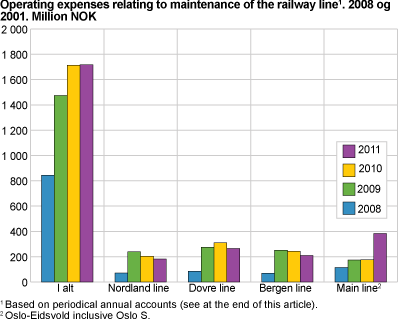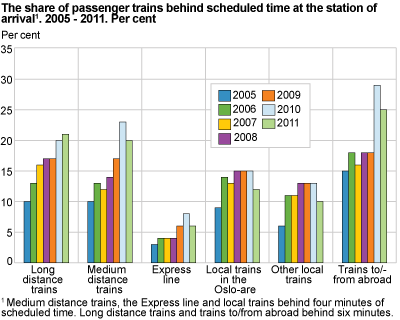Content
Published:
This is an archived release.
More than 530 man-years in two years
The total number of man-years in the Norwegian National Rail Administration adjusted for long-term leave, increased by 532 or 18 per cent from 2009 to 3 550 in 2011. At the same time, wages increased by NOK 490 million to almost NOK 2.6 billion.
The women’s share of positions, adjusted for long-term leave, constituted 17 per cent in 2009. Two years later the same share was 2 percentage points higher. The share of employees younger than 30 years increased from 10 per cent in 2009 to 15 per cent in 2011 to 550. At the same time as the number of both younger employees and women have increased in the Norwegian National Rail Administration, the share of employees with higher education also increased, from 9 per cent in 2009 to 11 per cent in 2011.
NOK 1.7 billion to the line
The costs spent on the maintenance and upgrading of the infrastructure came to NOK 4.0 billion in 2011; a growth of 6 per cent from 2010. NOK 1.7 billion related to the maintenance and upgrading of the railway line. Signalling/interlockings and electrification were other significant maintenance items, with about NOK 870 million in total in 2011.
More trains in accordance with schedule in 2011.
The statistics show a fall in punctuality from 2005 to 2010 for all types of train. The share of delayed trains was doubled in this period. In 2011, the negative trend in punctuality was broken with the exception of a tiny fall in punctuality for the long distance trains. The long distance trains on the Bergen line contributed most to the fall in punctuality, while the railway traffic on the Nordland line had the highest increase in punctuality of the long distance trains. On average, 24 per cent of the trains on these two lines were delayed in 2010. In 2011 the shares were 28 per cent and 16 per cent respectively. In both 2010 and 2011, the trains from abroad were most frequently delayed. Twenty-five per cent of these trains were delayed in 2011; an improved punctuality by 5 percentage points from 2010.
..and less hours of dead time
About 10 600 hours of dead time for both passenger and goods trains were caused by incidents related to infrastructure and external conditions in 2011. This was a decrease of 1 300 hours compared to 2010 and at the same level as for 2008 and 2009.
About 3 500 level crossings and some more passing loops
The number of level crossings has been gradually reduced in recent years in accordance with the goal stated in the National plan for transport. In 2011, there were 3 510 such crossings; a reduction of 15 per cent compared to 2005 and almost 3 per cent compared to 2010.
The total length of the Norwegian railway network was 4 154 kilometres in 2011. Only 6 per cent of tracks are double tracks, which means passing loops are needed for flexible traffic organisation. The statistics show zero increase in total passing loops, but there was an increase of three passing loops of 600 metres or longer.
Public railway operationRailway infrastructure administratorUntil 1996, both the administration of the railway infrastructure and train transport were placed under the public management company Norwegian State Railways. This company was subsequently split in two: The administrative body Norwegian National Rail Administration and the public-owned company Norwegian State Railways plc (which changed to a private limited company in July 2002). Norwegian National Rail Administration is responsible for administrating the railway infrastructure, the operational management of trains and assigning routes. The enterprise was included in StatRes in 2008. AllocationsThe activity of the Norwegian National Rail Administration is entirely based on governmental allocations. Periodical annual accountsIn addition to keeping the normal cash flow accounting, the Norwegian National Rail Administration also delivers periodical annual accounts for public enterprises. The Norwegian National Rail Administration has kept such accounts since 2005 based on the standards developed for these types of accounts. The figures referred to in this article are in accordance with the periodical annual accounts. |
What is StatRes?The governmental activity within administrating the railway infrastructure, the operational management of trains and assigning routes form part of StatRes - State resource use and results. The purpose of StatRes is to show the level of resources that the state uses, what this input provides in terms of activities and services in the various government activities, and what outcomes can be seen from the input. Its aim is to provide the general public and the authorities with more knowledge of state-run activities. |
Find more figures
Also find statistics about the quality of the track, number of stations, platforms, tunnels and bridges.
Additional information
The statistics give an overview of the amount of resources the Norwegian National Rail Administration spends on administrating the infrastructure, the operational management of trains and assigning routes, and the results of the effort.
Contact
-
Statistics Norway's Information Centre
E-mail: informasjon@ssb.no
tel.: (+47) 21 09 46 42


